Flip Mino HD 3rd Generation review
Newly updated, the Mino HD addresses some of the shortcomings of its second-gen brother, but does it do enough?

Pocketable and sleek, the new Flip Mino HD is the latest in the line of genre-defining video capture devices from Cisco. The original Flip made much of its ease of use and no-faff ability to shoot decent video from the hip, and it’s a concept this third generation model is following to the full.
Bang in the middle of the device is a big red button, which offers pretty much instantaneous recording, and the device will immediately begin capturing 720p video to the onboard storage.
Flip USB
Touch-sensitive controls navigate the menus and prompts video playback on its tiny 2in screen, or you can take advantage of the HDMI port for watching on your HDTV. Uploading dailies online, via the Flip’s USB connector, is straightforward. Neatly hidden when not required, it literally springs into action to connect the device to your PC. The onboard FlipShare software is some of the best around and makes short work of uploading clips to YouTube or Facebook accounts.
While connected, the Flip recharges its built-in battery, ready for the next mission. The new generation also sees the return of a 4GB model in silver alongside the black 8GB version, delivering around one or two hours of recording time – about the limit of the battery life, anyway.
Faster framerate
The f2.4 lens gives the device a slightly wider aperture than many similar mini camcorders, which should in theory make it better at shooting in low light. In reality the difference is fairly minimal – you will pick up some sort of images in dark corners, but with so much noise that it’s hardly worth it.
The framerate at 50fps is almost twice as fast as previous models, and gives a much smoother final result. It also helps combat the shearing effect, caused by the progressive scanning on CMOS sensors, when panning the camera. It certainly reduces it, but doesn’t eliminate it entirely, which is practically impossible with the sensors used in these types of cameras.
Image stabilisation makes a slight difference to your drunken party shots, but if you want a watchable experience, you would still be advised to make use of the standard tripod mount on the bottom.
Major improvement?
With this third-generation HD model, there was an opportunity to fix some of the issues with its predecessor and further distance the Flip from up-and-coming competition like the Creative Vado and Kodak‘s increasingly impressive range. And while the enhancements are welcome – increased framerate, the introduction of image stabilization and slicker FlipShare software – they still don’t feel significant enough.
Designed for those that would just like to fire and forget when it comes to shooting video, the Mino HD certainly hits its target, but with a new range of more versatile devices on the market, it isn’t the automatic first choice any more.



